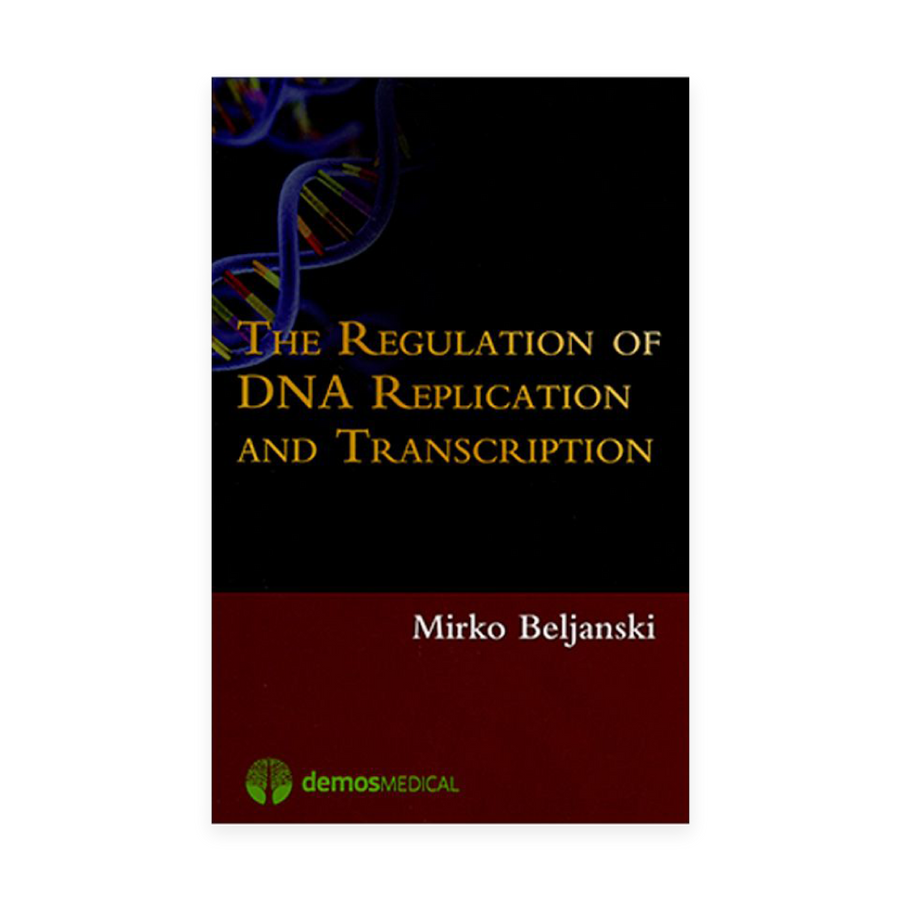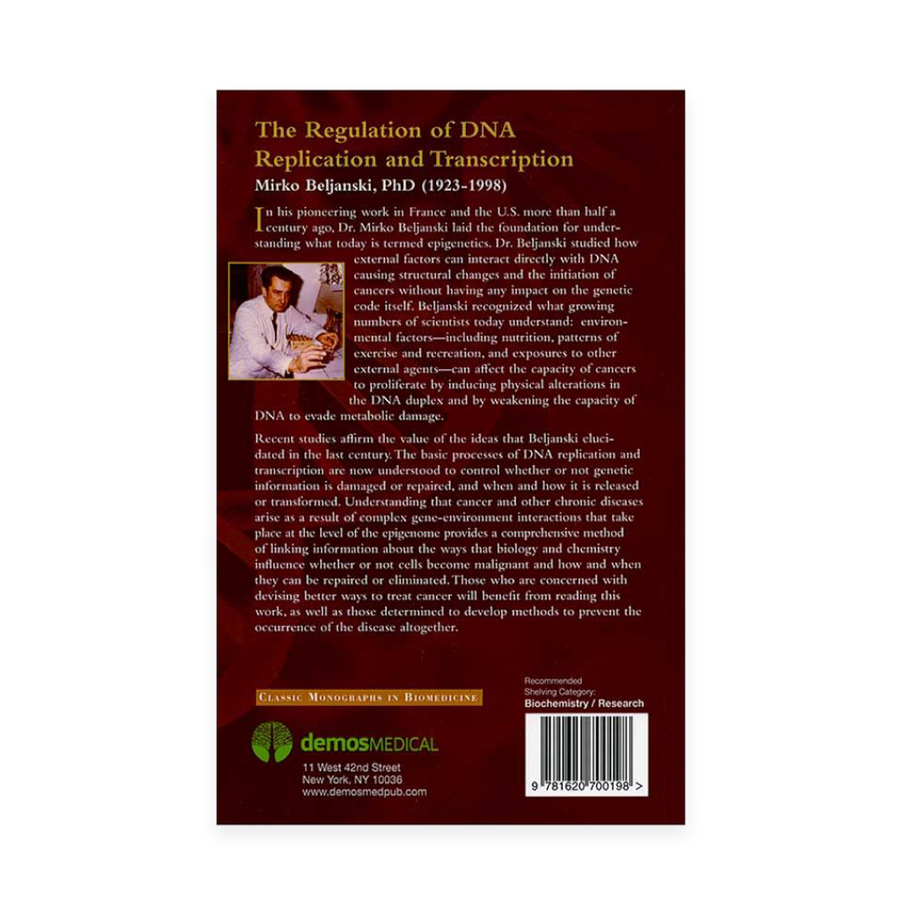
The Regulation of DNA Replication and Transcription
Just in time for the 30th anniversary of the 1983 original publication with Karger, this 3rd Edition has been published with scientific commentary and evidentiary support of Mirko Beljanski's groundbreaking discoveries, given by Dr. Devra Davis, PhD, MPH. In his pioneering work in France and the U.S. more than half a century ago, Dr. Mirko Beljanski laid the foundation for understanding what today is termed, Epigenetics.
Coming Soon
- Discounts on each order
- Flexibility to adjust or cancel anytime
- Reminders before each delivery
Overview
Dr. Beljanski studied how external factors can interact directly with DNA causing structural changes and the initiation of cancers without having any impact on the genetic code itself. Beljanski recognized what growing numbers of scientists today understand: environmental factors – including nutrition, patterns of exercise and recreation, and exposure to other external agents – can affect the capacity of cancers to proliferate by inducing physical alterations in the DNA duplex by weakening the capacity of DNA to evade metabolic damage.
Recent studies affirm the value of the ideas that Beljanski elucidated in the last century. The basic processes of DNA replication and transcription are now understood to control whether or not genetic information is damaged or repaired, and when and how it is released or transformed. Understanding that cancer and other chronic diseases arise as a result of complex gene-environment interactions that take place at the level of the epigenome provides a comprehensive way of linking information about the ways that biology and chemistry influence whether or not cells become malignant and how and when they can be repaired or eliminated.
Those who share our concerns with devising better ways to treat cancer will benefit from reading this work, as well as those determined to develop methods to prevent the occurrence of disease altogether.
| ISBN-13 | 978-1620700198 |
| Publisher | Demos Medical |
| Publication date | 3/30/2013 (1st re-edition) |
| Pages | 225 |
Dr. Mirko Beljanski was one of the first molecular biologists to study RNA, which plays a dynamic role in cell regulation. In 1960, he was awarded the Charles Léopold Mayer prize after having spent two years at NYU Medical School (1956-1958) working with Nobel Prize winner Professor Severo Ochoa. For almost 50 years, he studied DNA and RNA biology and made numerous discoveries. For example, he found that reverse transcriptases exist not only in viruses, but also in other types of organisms, including bacteria, fungus, and fish.
Within the scientific community at the time, the difference between normal and cancerous DNA was considered to be caused by mutations, meaning alterations of the DNA’s primary structure. This explanation is still held to be true though the focus today is on oncogenes as their harmful activity is considered to derive from mutations that have occurred in normal proto-oncogenes. In contrast, Mirko Beljanski demonstrated that the fundamental difference between normal and cancer DNA really lies in its secondary structure: the cancer DNA double helix is permanently opened over large areas, whereas in normal DNA, relaxation only occurs locally and temporarily for replication or gene expression. Unregulated strand separation, and the ensuing replication and gene expression due to newly exposed initiation sites, account for the characteristic properties of the cancer cell, namely its enhanced multiplication and spurious protein synthesis.
Unfortunately, Dr. Beljanski was forced to leave the Pasteur Institute as his innovative ideas drastically conflicted with the Institute’s new director, Jacques Monod. Passionate about these findings, Mirko Beljanski continued his work at the Chatenay-Malabry School of Pharmacy where he benefited from his knowledge of cellular regulation to design supplements capable of helping people without harmful side effects.
In 1988, by then officially retired, Mirko Beljanski created his own Centre de Recherche Biologique (CERBIOL) in Saint Prim, close to Lyon, where he perfected his extracts and continued to publish. He published a total of 133 scientific papers, wrote 2 books, and filed 11 patents over his lifetime.
In spite of a considerable progress accomplished by biologists, biochemists and embryologists during the last 20 years in order to understand the cell differentiation and tissue development, the mechanism of gene activation remained essentially unclarified. The main difficulties arise from a tremendous degree of conformational complexity of the DNA double-helix structure and from the fact that it is very difficult to analyze with accuracy numerous biochemical pathways interfering in gene activation or inactivation in situ. To this it should be added that extrapolation of data collected by biochemists with the in vitro biological systems cannot be automatically applied to living organisms. Cell complexity and cell-to-cell interaction constitute a puzzle for scientists since these events are connected with gene activation or inactivation and regulation of DNA replication.
Variable activity of genes in a constant genome is taken as a basis for studying gene activation or inactivation through cell differentiation and proliferation. The expression of gene activity is usually followed by the appearance either of specific protein or messenger RNA, both in close relationship with DNA replication. These studies are not easy to perform due to the existence in eukaryotes of high molecular weight precursor RNAs from which emerge a variety of 'mosaic' messenger RNAs.
"The emphasis of this book is on the role of trigger molecules in gene expression in normal and malignant cells. Examples and experimental data are presented from both animal and plant models. There are six chapters which cover such topics as the control and initiation of DNA replication, the release of information from DNA, the involvement of endogenous RNA molecules in gene expression and cellular transformation, and the effect of carcinogens on DNA replication and transcription. The final chapter gives an account of how endogenous and exogenous molecules are directly involved in the basic mechanisms of gene activation.
Chapters 1 and 2 deal with the initiation and control of DNA replication and transcription and are basically an assemblage of experimental results showing the complex nature of the various steps that regulate these fundamental processes. They provide sufficient background for laymen and beginning students to understand more specific topics, such as interactions of steroid hormones and carcinogens with DNA, that are covered in later chapters. Chapter 6 pools together the information from the earlier chapters to impress upon the that the basic molecular mechanisms of gene activation and inactivation involve various endogenous and exogenous molecules.
The illustrations contained within each chapter (29 figures and 2 tables) are well done and easy to interpret. In addition, there is a summary at the end of each chapter and a discussion and recapitulation section at the end of the book, which highlight the topics dealt with in each chapter as they relate to the regulation of gene expression. For the expert the book is a good source of reference material. For the layman and beginning student the book provides sufficient background and an adequate discussion of the large and complex subject of the regulation of gene expression in both animal and plant systems."
W. Edward Mercer
Pathology, Temple University School of Medicine, Philadelphia, PA








